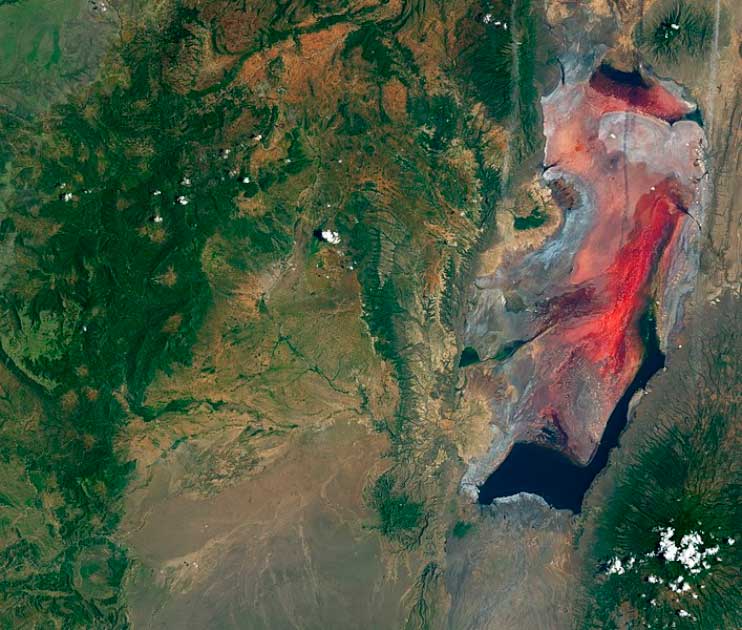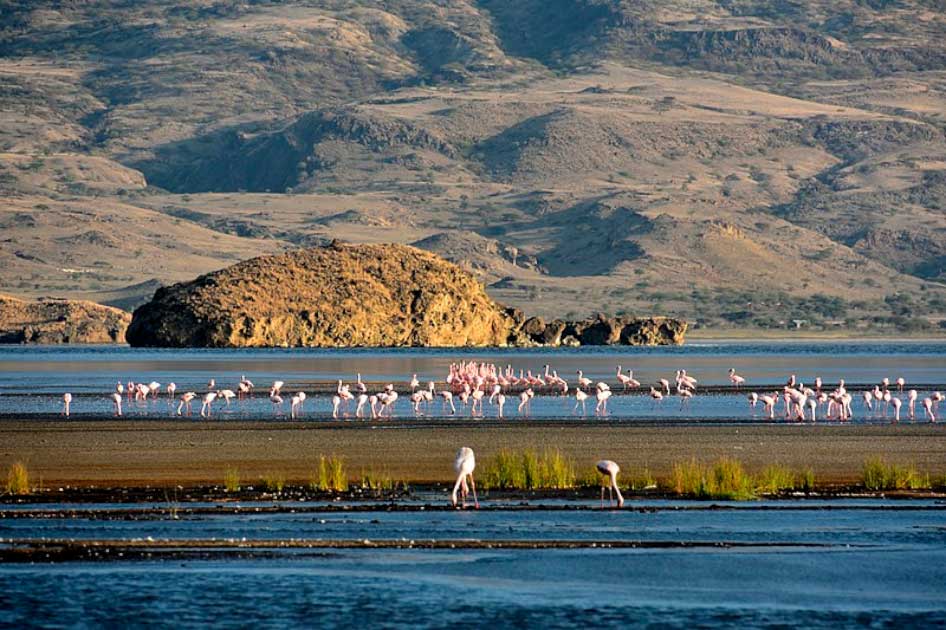Lake Natron is an alkaline saltwater lake found in Tanzania. It is found more specifically, in the Ngorongoro District of the Arusha Region in Tanzania. Another identifier for it is that it is situated in the Gregory Rift which is itself part of the Eastern arm of the East African Rift caused by tectonic plate movement. Lake Natron has been recognized as a site wetland of international significance.
However, it did not come onto the international scene until photographer, Nick Brandt, recorded it for his book on the disappearing wildlife of East Africa. He discovered the lake as a serene place but noticed that all of the creatures surrounding the water were petrified: they had turned to stone.
It sounds like something out of an ancient Greek epic, but this place truly exists and does actually turn the wildlife around it to stone. Brandt recorded these in his photos, but it still does not answer why? Here is an explanation.
Lake Natron
The lake itself is fed mostly by the Ewaso Ng’iro River. This river rises in Central Kenya and because of this, the water is filled with minerals and is surrounded by hot springs. The lake is less than three meters (10 feet) deep and has a varying width depending on the water level.
It is not a small lake either, being around 14 miles wide and 35 miles long (23 km by 56 km). The area gets seasonal but irregular rainfall between December and May with temperatures rising to above 40 degrees Celsius (104 degrees Fahrenheit).

Due to the temperatures getting so high and the lack of rainfall, there are high levels of evaporation. This leaves behind Natron and trona: chemically sodium carbonate decahydrate and sodium sesquicarbonate dihydrate respectively.
The PH of the lake thus rises to that greater of 12, similar to that of alkaline bleach or caustic lye. To put this into perspective the scale only goes from 0 (acidic) to 14 (alkaline), with both extremes being highly hazardous. It can burn the skin and eyes of animals that are not acclimatized to it.
- The Secret of Lake Nyos: How Did 1,800 People Die Overnight?
- Dare You Enter the Ploutonion? Gateway to the Underworld at Hierapolis
Despite the high alkaline levels of the lake, there are still some naturally occurring flora. Salt-loving microorganisms can thrive in areas like these, forming a blue-green algae which add to the mysticism of the lake.
Depending on the levels of alkaline, this can also produce a red pigment that matches the color of the open water. There is often a crust of salt on the water that is colored pink and red.
Unsurprisingly however, many of the animals of the region struggle to live in such an inhospitable environment. This does not mean that the lake is completely bereft of wildlife. There are many forms of algae that thrive there.
As well as this, some invertebrates and birds live there, and even some fish survive in the borders of the lake in the slightly less salty areas. The area is known to be a breeding ground for lesser flamingos who rely on this area.
It is because of this reliance that they are in the status of near threatened. The flamingos gather alongside the lake which can support their nests and feed on the blue-green algae. The inhospitable nature of the lake allows this to be safe from predators who will not approach such an area.
Threats to the Lake
The area surrounding the lake is not inhabited by people. There exists some herding and seasonal cultivation. However, this does not mean that the area is not under threat.
The salinity balance of the area has increased in recent years due to the logging projects taking place in Natron watersheds as well as the planned hydroelectric power plant that is going to be placed on the river feeding Lake Natron. The area is not formally protected and so whilst there is a plan to mitigate any damages to the area, there is no legislation to enforce this.
Some are looking to actively take advantage of the extreme alkaline nature of the lake. Recently, a proposed soda ash plant is planning on developing on the shores of the lake. The plant would use the water to extract sodium carbonate and turn it into washing powder that could then be exported out of the country.
- Lake Avernus Mythology, Oracles, and the Underworld
- Lake Anjikuni: How Did an Entire Village Disappear?
In addition to the plant being built in the area, there would also need to be provisions for around 1,000 workers and a coal power station to provide energy to the complex. This would likely push the flamingos out of the area and push them into extinction.
Turned to Stone
When Nick Brandt stumbled across this unique environment, he was greeted with the well-preserved bodies of flamingos, eagles, bats, swallows, and other wildlife. He documented the eerie scene in photographs.
He placed these animal carcasses in “living” positions in order to create the illusion of instant petrification. His photos are on display in New York City. The animals that are unfortunate enough to fall into the lake die very quickly but are effectively pickled by the alkaline levels of the lake. The salt preserves them.

It is not unusual for migrating birds, unaccustomed to the lake’s environment to crash into the surface of the water. It has been theorized that the water is so chemically dense that the water looks glassy to birds. They believe they are flying toward a heated air space but instead, they are flying to a watery and painful death.
If this has not put you off the idea or if you are morbidly interested in the animals and how they are left by the lakeside, then you can still visit the area. There are several campgrounds near the lake. They are used for climbing the OI Doinyo Lengai, the Maasai “Mountain of God” nearby.
The lake attracts lots of tourists and has a huge potential for ecotourism. However, as is often the case with these things in areas such as Tanzania, there is a lack of management and the infrastructure of passion for such a cause.
You can still get to the area by going through Shompole Conservancy in Kenya. It may be difficult to get to but it would be quite a wonder to see such a unique environment reminiscent of a portal to the underworld from the ancient Greek myths.
Top Image: The highly alkaline nature of Lake Natron kills most animals, turning them into petrified statues after their deaths. Source: Vera / Adobe Stock.
By Kurt Readman